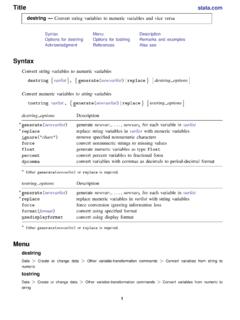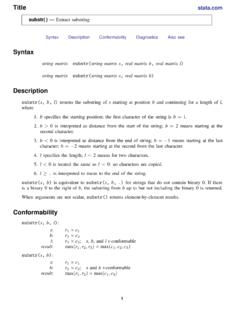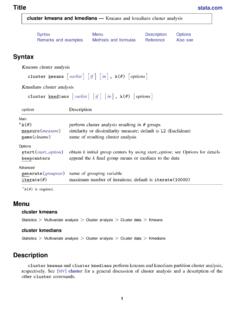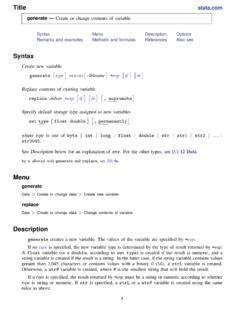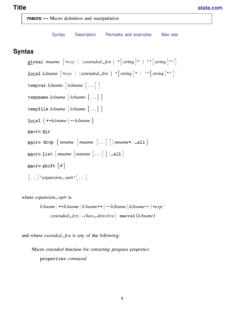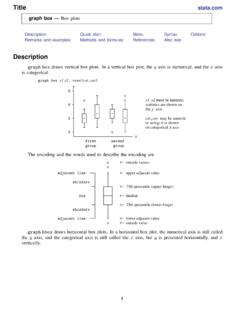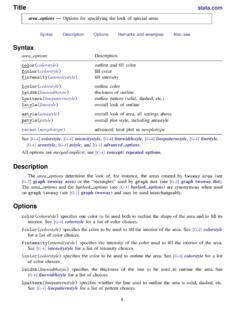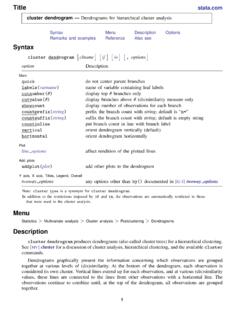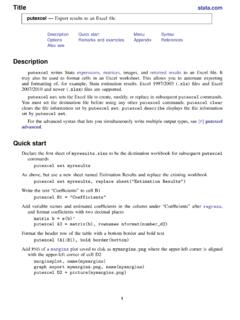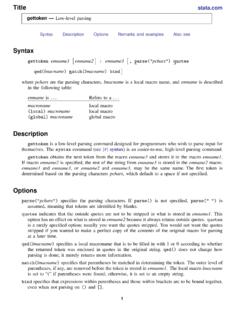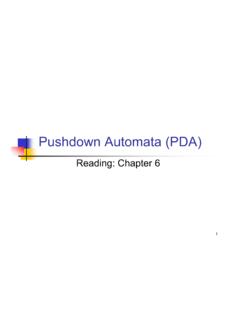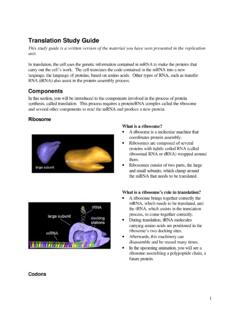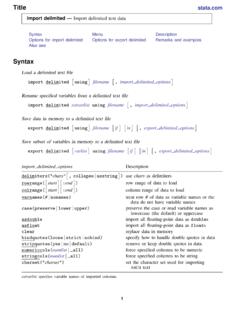Transcription of Stata: Software for Statistics and Data Science | Stata
1 Merge datasetsSyntaxMenuDescriptionOptionsRema rks and examplesReferencesAlso seeSyntaxOne-to-one merge on specified key variablesmerge 1:1varlistusingfilename[,options]Many-to -one merge on specified key variablesmerge m:1varlistusingfilename[,options]One-to- many merge on specified key variablesmerge 1:mvarlistusingfilename[,options]Many-to -many merge on specified key variablesmerge m:mvarlistusingfilename[,options]One-to- one merge by observationmerge 1:1n usingfilename[,options]optionsDescriptio nOptionskeepusing(varlist)variables to keep from using data; default is allgenerate(newvar)name of new variable to mark merge results; default ismergenogeneratedo not createmergevariablenolabeldo not copy value-label definitions from usingnonotesdo not copy notes from usingupdateupdate missing values of same-named variables in master with valuesfrom usingreplacereplace all values of same-named variables in master with nonmissingvalues from using (requiresupdate)noreportdo not display match result summary tableforceallow string /numeric variable type mismatch without errorResultsassert(results)specify required match resultskeep(results)specify which match results to keepsorteddo not sort.
2 Dataset already sortedsorteddoes not appear in the dialog merge Merge datasetsMenuData>Combine datasets>Merge two datasetsDescriptionmergejoins corresponding observations from the dataset currently in memory (called the masterdataset) with those (called the using dataset), matching on one or more perform match merges (one-to-one, one-to-many, many-to-one, and many-to-many), which are often calledjoinsby database also perform sequential merges,which have no equivalent in the relational database for adding new variables from a second dataset to existing observations. You usemerge, for instance, when combining hospital patient and discharge datasets.
3 If you wish to add newobservations to existing variables, then see [D]append. You useappend, for instance, when addingcurrent discharges to past default,mergecreates a new variable,merge, containing numeric codes concerning the sourceand the contents of each observation in the merged dataset. These codes are explained below in thematch results variables cannot specified without an extension, Options keepusing(varlist)specifies the variables from the using dataset that are kept in the merged default, all variables are kept. For example, if your using dataset contains 2,000 demographiccharacteristics but you want onlysexandage, then typemerge.., keepusing(sex age).
4 Generate(newvar)specifies that the variable containing match results information should be namednewvarrather thatmergenot be created. This would be useful if you also specifiedkeep(match), becausekeep(match)ensures that all values ofmergewould be that value-label definitions from the using file be ignored. This option should berare, because definitions from the master are already that notes in the using dataset not be added to the merged dataset; see [D] perform an update merge rather than a standard merge. In a standardmerge, the data in the master are the authority and inviolable. For example, if the master andusing datasets both contain a variableage, then matched observations will contain values from themaster dataset, while unmatched observations will contain values from their respective specified, then matched observations will update missing values from the master datasetwith values from the using dataset.
5 Nonmissing values in the master dataset will be specified, then matched observations will contain values from the using dataset,unless the value in the using dataset is eitherupdateorreplaceaffects the meanings of the match codes. SeeTreatment ofoverlapping variablesfor Merge datasets 3noreportspecifies thatmergenot present its summary table of match string /numeric variable type mismatches, resulting in missing values from the usingdataset. If omitted,mergeissues an error; if specified,mergeissues a warning. Results assert(results)specifies the required match results. The possibleresultsareNumericEquivalentcodew ord (results)Description1 masterobservation appeared in master only2 usingobservation appeared in using only3 matchobservation appeared in both4 matchupdateobservation appeared in both, missing values updated5 matchconflictobservation appeared in both, conflicting nonmissingvaluesCodes 4 and 5 can arise only if theupdateoption is specified.
6 If codes of both4 and 5 could pertain to an observation, then 5 is codes and words are equivalent when used in theassert()orkeep() following synonyms are allowed:mastersformaster,usingsforusing, matchesandmatchedformatch,matchupdatesfo rmatchupdate, (match master)specifies that the merged file is required to include only matchedmaster or using observations and unmatched master observations, and may not include unmatchedusing observations. Specifyingassert()results inmergeissuing an error if there are matchresults among those observations you order of the words or codes is not important, so all the followingassert()specificationswould be the same:assert(match master)assert(master matches)assert(1 3)When the match results contain codes other than those allowed, return code 9 is returned, and themerged dataset with the unanticipated results is left in memory to allow you to (results)specifies which observations are to be kept from the merged dataset.
7 Usingkeep(matchmaster)specifies keeping only matched observations and unmatched master observations ()differs fromassert()because it selects observations from the merged dataset rather thanenforcing ()is used to pare the merged dataset to a given set of observationswhen you do not care if there are other observations in the merged ()is used toverify that only a given set of observations is in the merged can specify bothassert()andkeep(). If you require matched observations and unmatchedmaster observations but you want only the matched observations, then you could specifyas-sert(match master) keep(match).4 merge Merge datasetsassert()andkeep()are convenience options whose functionality can be duplicated merge.
8 , assert(match master) keep(match)is identical to. merge.. assert _merge==1 | _merge==3. keep if _merge==3 The following option is available withmergebut is not shown in the dialog box:sortedspecifies that the master and using datasets are already sorted byvarlist. If the datasets arealready sorted, thenmergeruns a little more quickly; the difference is hardly detectable, so thisoption is of interest only where speed is of the utmost and are presented under the following headings:OverviewBasic description1:1 mergesm:1 merges1:m mergesm:m mergesSequential mergesTreatment of overlapping variablesSort orderTroubleshooting m:m mergesExamplesOverviewmerge 1:1varlist.
9 Specifies a one-to-one match variables common toboth datasets that together uniquely identify single observations in both datasets. For instance, supposeyou have a dataset of customer information, , and have a second dataset of otherinformation about roughly the same customers, Suppose further that both datasetsidentify individuals by using thepidvariable, and there is only one observation per individual ineach dataset. You would merge the two datasets by typing. use customer. merge 1:1 pid using otherReversing the roles of the two files would be fine. Choosing which dataset is the master and whichis the using matters only if there are overlapping variable :1merges are less common than1: 1:mandmerge m:1specify one-to-many and many-to-one match merges, illustrate the two choices, suppose you have a dataset containing information about individualhospitals, In this dataset, each observation contains information about onehospital, which is uniquely identified by thehospitalidvariable.
10 You have a second dataset , which contains information on individual hospital stays by many different identifies hospitals by using thehospitalidvariable. You would like to joinall the information in both datasets. There are two ways you could do Merge datasets 5merge 1:mvarlist..specifies a one-to-many match use hospitals. merge 1:m hospitalid using dischargeswould join the discharge data to the hospital data. This is a1:mmerge becausehospitaliduniquelyidentifies individual observations in the dataset in memory (hospitals), but could correspond tomany observations in the using m:1varlist..specifies a many-to-one match use discharges. merge m:1 hospitalid using hospitalswould join the hospital data to the discharge data.
